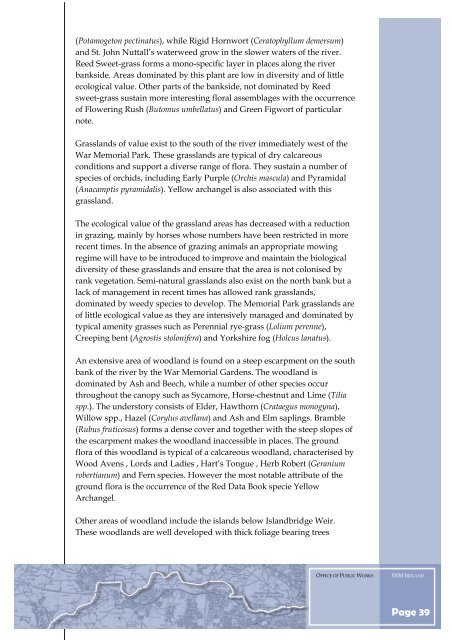Towards a Liffey Valley Strategy Doc. 1 - Kildare.ie
Towards a Liffey Valley Strategy Doc. 1 - Kildare.ie
Towards a Liffey Valley Strategy Doc. 1 - Kildare.ie
Create successful ePaper yourself
Turn your PDF publications into a flip-book with our unique Google optimized e-Paper software.
(Potamogeton pectinatus), while Rigid Hornwort (Ceratophyllum demersum)<br />
and St. John Nuttall’s waterweed grow in the slower waters of the river.<br />
Reed Sweet-grass forms a mono-specific layer in places along the river<br />
bankside. Areas dominated by this plant are low in diversity and of little<br />
ecological value. Other parts of the bankside, not dominated by Reed<br />
sweet-grass sustain more interesting floral assemblages with the occurrence<br />
of Flowering Rush (Butomus umbellatus) and Green Figwort of particular<br />
note.<br />
Grasslands of value exist to the south of the river immediately west of the<br />
War Memorial Park. These grasslands are typical of dry calcareous<br />
conditions and support a diverse range of flora. They sustain a number of<br />
spec<strong>ie</strong>s of orchids, including Early Purple (Orchis mascula) and Pyramidal<br />
(Anacamptis pyramidalis). Yellow archangel is also associated with this<br />
grassland.<br />
The ecological value of the grassland areas has decreased with a reduction<br />
in grazing, mainly by horses whose numbers have been restricted in more<br />
recent times. In the absence of grazing animals an appropriate mowing<br />
regime will have to be introduced to improve and maintain the biological<br />
diversity of these grasslands and ensure that the area is not colonised by<br />
rank vegetation. Semi-natural grasslands also exist on the north bank but a<br />
lack of management in recent times has allowed rank grasslands,<br />
dominated by weedy spec<strong>ie</strong>s to develop. The Memorial Park grasslands are<br />
of little ecological value as they are intensively managed and dominated by<br />
typical amenity grasses such as Perennial rye-grass (Lolium perenne),<br />
Creeping bent (Agrostis stolonifera) and Yorkshire fog (Holcus lanatus).<br />
An extensive area of woodland is found on a steep escarpment on the south<br />
bank of the river by the War Memorial Gardens. The woodland is<br />
dominated by Ash and Beech, while a number of other spec<strong>ie</strong>s occur<br />
throughout the canopy such as Sycamore, Horse-chestnut and Lime (Tilia<br />
spp.). The understory consists of Elder, Hawthorn (Crataegus monogyna),<br />
Willow spp., Hazel (Corylus avellana) and Ash and Elm saplings. Bramble<br />
(Rubus fruticosus) forms a dense cover and together with the steep slopes of<br />
the escarpment makes the woodland inaccessible in places. The ground<br />
flora of this woodland is typical of a calcareous woodland, characterised by<br />
Wood Avens , Lords and Lad<strong>ie</strong>s , Hart’s Tongue , Herb Robert (Geranium<br />
robertianum) and Fern spec<strong>ie</strong>s. However the most notable attribute of the<br />
ground flora is the occurrence of the Red Data Book spec<strong>ie</strong> Yellow<br />
Archangel.<br />
Other areas of woodland include the islands below Islandbridge Weir.<br />
These woodlands are well developed with thick foliage bearing trees<br />
OFFICE OF PUBLIC WORKS ERM IRELAND<br />
Page 39
















